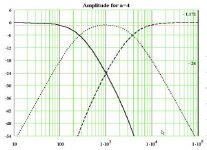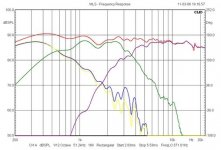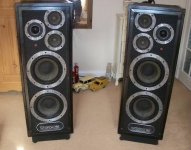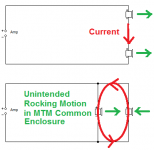Hello everyone, I am new in this forum, and I really need advices for my project ...
Actually, I am in Tunisia, we don't have any any raw speakers here appart from pro audio like Celestion, Dynacord, and so on, not really suitable for my usage here, so I ll need to ask one of my freinds to buy some drivers for me from France, Germany, however, this mean that I will have to go blind.
I am reading for about a mounth many forums (specially here) for how to do it, what drivers etc etc, now I decided to go next step and buy some drivers.
I want to go with MTMWW design here is my selection (for now, budget wise/ weight wise) :
tweeters : Vifa XT25TG30
mid-ranges : Tang Band W3-871B or Tang Band W4-1052SDF
woofer : Tang Band W6-1139SIF
Now, I have some scientific background but I am in computer sciences so it will cost me more efforts to really study all electric interractions/crossovering etc etc, so I want to ask your opinion for this selection already, regarding frequecies responses, drivers sensitivity/coherence .... etc
what I am planing to do is :
MTMWW enclosure, the WW compartiment would be a T-Line Design
the crossover would be ouside the enclosure because I am planning to use it with active crossover (but keep the option of passive one)
all opinions, suggestions, ideas, are very welcome
Actually, I am in Tunisia, we don't have any any raw speakers here appart from pro audio like Celestion, Dynacord, and so on, not really suitable for my usage here, so I ll need to ask one of my freinds to buy some drivers for me from France, Germany, however, this mean that I will have to go blind.
I am reading for about a mounth many forums (specially here) for how to do it, what drivers etc etc, now I decided to go next step and buy some drivers.
I want to go with MTMWW design here is my selection (for now, budget wise/ weight wise) :
tweeters : Vifa XT25TG30
mid-ranges : Tang Band W3-871B or Tang Band W4-1052SDF
woofer : Tang Band W6-1139SIF
Now, I have some scientific background but I am in computer sciences so it will cost me more efforts to really study all electric interractions/crossovering etc etc, so I want to ask your opinion for this selection already, regarding frequecies responses, drivers sensitivity/coherence .... etc
what I am planing to do is :
MTMWW enclosure, the WW compartiment would be a T-Line Design
the crossover would be ouside the enclosure because I am planning to use it with active crossover (but keep the option of passive one)
all opinions, suggestions, ideas, are very welcome
Last edited:
You need to back up and go simple.
A 3-way is 2x harder than a 2-way. If you MUST do a 3-way or anything more complicated for your first, you really really really should do a pre-designed kit.
Lots of those around with parts sourceable in the EU. Three good sites:
DIY-Loudspeakers
http://www.solen.ca
Zaph|Audio
Otherwise, may God have mercy on your poor lost soul.
Best,
E
A 3-way is 2x harder than a 2-way. If you MUST do a 3-way or anything more complicated for your first, you really really really should do a pre-designed kit.
Lots of those around with parts sourceable in the EU. Three good sites:
DIY-Loudspeakers
http://www.solen.ca
Zaph|Audio
Otherwise, may God have mercy on your poor lost soul.
Best,
E
I actually think a 3 way is far easier than a two way! 
But choose easy and flat drivers. SEAS-3-Way-Classic
Particularly a flat midrange. All you are doing is sparing the mid from bottom and top duties. So it works better.
Steen Duelund worked out the mathematical theory. The extent to which Troels got close to the right curve determines success. Actually with a 3 way, you can use shallower LR2 aka 12dB/octave filters and keep distortion low. Less demanding, you see.
But choose easy and flat drivers. SEAS-3-Way-Classic
Particularly a flat midrange. All you are doing is sparing the mid from bottom and top duties. So it works better.
Steen Duelund worked out the mathematical theory. The extent to which Troels got close to the right curve determines success. Actually with a 3 way, you can use shallower LR2 aka 12dB/octave filters and keep distortion low. Less demanding, you see.
Attachments
I'm fairly familiar with some of the Eminence Big efficient woofer plus horn tweeter ideas, even built them myself, and they can sure go loud.
But it's not the only road to high efficiency.
Here's a Wharfedale E90 WWMTM design. Genius, IMO. Simple LR2 crossover with the mids wired in series. This is a loud PA speaker in essence. I like the idea of twin drivers. You get 4X the level for the same distortion. And it fills the room.
But what a monster to build!
But it's not the only road to high efficiency.
Here's a Wharfedale E90 WWMTM design. Genius, IMO. Simple LR2 crossover with the mids wired in series. This is a loud PA speaker in essence. I like the idea of twin drivers. You get 4X the level for the same distortion. And it fills the room.
But what a monster to build!
Attachments
Yes, party people in the place...
What about the speaker system that Mansa201 selected ?
I'd say, most important thing is the impedance curve, since the speakers need to be attached to an amplifier.
A double driver arrangement suggests that driver will be connected in parallel or in series.
The first is preferred ( why ?) but Z goes low.
It cannot be applied to the TB woofer since they are 4 Ω . Active driving is better...but also 4+4 =8Ω could be electrically good. The standard hifi is 8Ω.
The midrange, they need to be put in parallel.
What about the speaker system that Mansa201 selected ?
I'd say, most important thing is the impedance curve, since the speakers need to be attached to an amplifier.
A double driver arrangement suggests that driver will be connected in parallel or in series.
The first is preferred ( why ?) but Z goes low.
It cannot be applied to the TB woofer since they are 4 Ω . Active driving is better...but also 4+4 =8Ω could be electrically good. The standard hifi is 8Ω.
The midrange, they need to be put in parallel.
Pico, I actually think parallel wired drivers are very bad news indeed. At least in a common enclosure.
See, the natural tendency is if one driver is pushing out, the natural tendency is for the other to go in. It's just a nasty natural resonance. Out of phase, if you follow. Below.
When you wire two drivers in series, they get the same current, so work together.
I could quickly convert Troels' 3 way classic to multiple series drivers. Double inductance and resistance and halve capacitance in the filters. In fact I think the quickest way to a flattish impedance is using twin 8 ohm mids with single 8 ohm woofers and 8 ohm tweeters. Because the problem with 3 ways is always a low impedance in the mids.
I like the idea of impedance correction with speakers. mh-audio.nl - Home
A flattish impedance is just a thoroughly good idea with amplifiers of any sort. They just work well. Rogers Loudspeakers › LS5/9
See, the natural tendency is if one driver is pushing out, the natural tendency is for the other to go in. It's just a nasty natural resonance. Out of phase, if you follow. Below.
When you wire two drivers in series, they get the same current, so work together.
I could quickly convert Troels' 3 way classic to multiple series drivers. Double inductance and resistance and halve capacitance in the filters. In fact I think the quickest way to a flattish impedance is using twin 8 ohm mids with single 8 ohm woofers and 8 ohm tweeters. Because the problem with 3 ways is always a low impedance in the mids.
I like the idea of impedance correction with speakers. mh-audio.nl - Home
A flattish impedance is just a thoroughly good idea with amplifiers of any sort. They just work well. Rogers Loudspeakers › LS5/9
Attachments
And what IF you discover that the system is not LTI and measuring it is useless, and brings to catastrophic conclusions !?!

Otherwise, may God have mercy on your poor lost soul
Hi,
The Tang Band W6-1139SIF actually is a high mass and high inductance subwoofer. This means for a passive crossover, that the sensitivity of your speaker will be quite low (~80 dB) and the crossover to the midrange drivers might get complex and expensive due to the large component values. You also will burn a lot of power by attenuating mids and tweeter to 80 dB.
The question is, if more efficient woofers wouldn't also be able to produce enough bass in a transmission line.
The Tang Band W6-1139SIF actually is a high mass and high inductance subwoofer. This means for a passive crossover, that the sensitivity of your speaker will be quite low (~80 dB) and the crossover to the midrange drivers might get complex and expensive due to the large component values. You also will burn a lot of power by attenuating mids and tweeter to 80 dB.
The question is, if more efficient woofers wouldn't also be able to produce enough bass in a transmission line.

Hello all,
First of all, I want to thank you very very much for all your answers. Now, some presicions have to be made :
First, after having tested and used many speakers now I have two bookshelfs Jamo Concert II which will be very hard to replace (I don't know If you know them very deep bass and smooth highs )
second, the final objective of the project is a 3 ways active speakers without any passive crossover, the passive crossover will just be made for flexibility and to use it when needed or even just one path of the crossover (the crossover will have to be 3 wiring wise) even when the passive crossover will be used, there will be minimum two amps used (one for the MTM section the other for bass)
I am trying to select speaker that can performe all the frequencies and will adjust the volume of each part when 3 amplifiers will be used ...
First of all, I want to thank you very very much for all your answers. Now, some presicions have to be made :
First, after having tested and used many speakers now I have two bookshelfs Jamo Concert II which will be very hard to replace (I don't know If you know them very deep bass and smooth highs )
second, the final objective of the project is a 3 ways active speakers without any passive crossover, the passive crossover will just be made for flexibility and to use it when needed or even just one path of the crossover (the crossover will have to be 3 wiring wise) even when the passive crossover will be used, there will be minimum two amps used (one for the MTM section the other for bass)
I am trying to select speaker that can performe all the frequencies and will adjust the volume of each part when 3 amplifiers will be used ...
Last edited:
Pico, I actually think parallel wired drivers are very bad news indeed. At least in a common enclosure.
Parallel or series doesn't make any difference at all, except impedance. (All other T/S-parameters are identical regardless of single, parallel or series use of a particular model of drivers. In other words, whatever is more convenient for the drivers you have can be done, no problem.
Some 'experts' make it up on the spot, it seems.
Some 'experts' make it up on the spot, it seems.
Wow. Way to win friends. Steve's dead right here. There are obvious differences, as Steve showed with his diagram. Push on one mid in a parallel MTM in a common enclosure and the emf (speakers are microphones) will cause the other cone to move out.
Additionally speakers are physical things with a natural spread to their parameters, so that should be taken into account.
Um, whether or not you push one driver and it affects the other is not really the issue. It is typically accepted as good practice to share acoustic spaces by identical drivers which share the same electrical signal, either in series or in parallel, whether or not they are sealed or ported.
The same forces will be distributed across the 2 or more drivers, though this may assume the drivers are within some wavelength away from each other.
It is the de-facto standard for commercial speakers. If there is literature suggesting this is less than optimal I have yet to come across it, and look forward to seeing that shared.
Best,
E
The same forces will be distributed across the 2 or more drivers, though this may assume the drivers are within some wavelength away from each other.
It is the de-facto standard for commercial speakers. If there is literature suggesting this is less than optimal I have yet to come across it, and look forward to seeing that shared.
Best,
E
UmIt is typically accepted as good practice to share acoustic spaces by identical drivers which share the same electrical signal
And about double drivers, IDK
( I was just asking...)
Wow. Way to win friends. Steve's dead right here. There are obvious differences, as Steve showed with his diagram. Push on one mid in a parallel MTM in a common enclosure and the emf (speakers are microphones) will cause the other cone to move out.
Additionally speakers are physical things with a natural spread to their parameters, so that should be taken into account.
Listen, I love you all, but please take your advice from those in the know. Like Eriksquires.
Steve's dead wrong. Its is not the first time he utters nonsense with great authority. I feel compelled to set him straight whenever I notice him doing so.
I have that, in a TLwhat about these woofers :
monacor SPH-165

Probably with a pair you smash the windows !
- Status
- This old topic is closed. If you want to reopen this topic, contact a moderator using the "Report Post" button.
- Home
- Loudspeakers
- Multi-Way
- New 3 Way project



